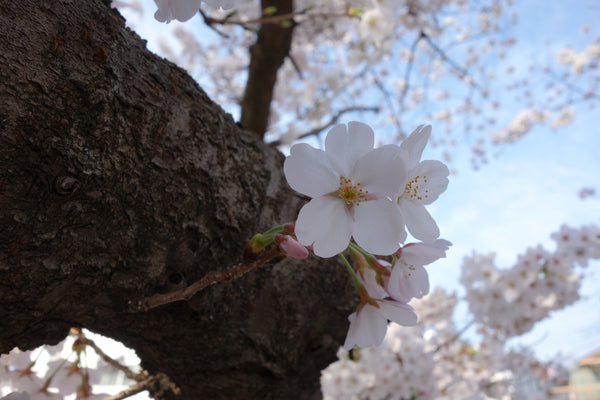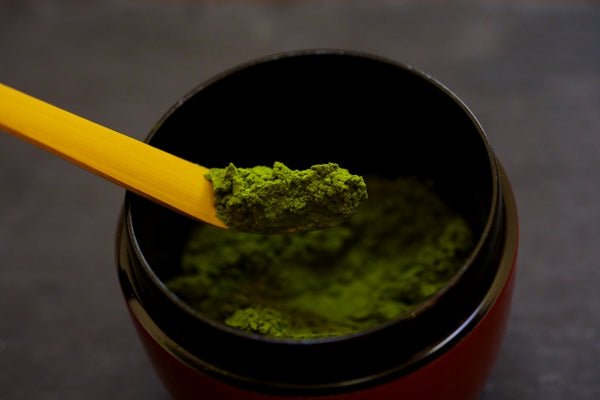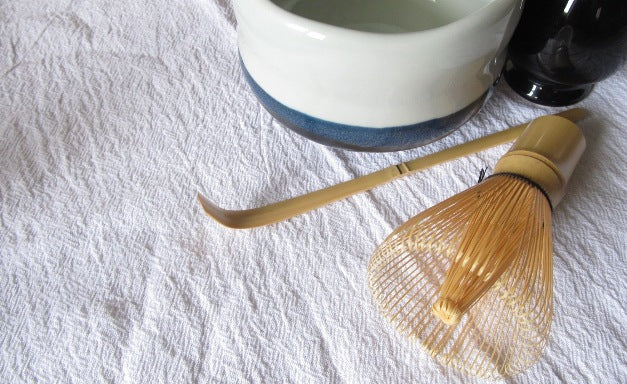Grace & Green offers the Best Organic Matcha Green Tea, Hojicha Powder etc. Here is FAQs we are often asked about our Japanese green teas and service. :)
1. What is matcha?
Matcha is a type of green tea made by finely grinding tea leaves into powder. Unlike traditional green tea, where the leaves are steeped and then discarded, matcha is mixed directly into hot water, allowing you to consume the entire tea leaf.
2. What makes matcha special?
Matcha is rich in antioxidants, particularly catechins, which may help boost metabolism, support brain function, and promote heart health. Additionally, it contains L-theanine, an amino acid that promotes relaxation and focus without causing drowsiness.
3. What does matcha taste like?
Matcha has a unique flavor profile that is vegetal, earthy, and slightly sweet. High-quality matcha is smooth and creamy with a balanced bitterness.
4. How do I prepare matcha?
Traditionally, matcha is prepared using a bamboo whisk (chasen) and a matcha bowl (chawan). To prepare, sift a small amount of matcha powder into the bowl, add hot water (approximately 80°C/176°F), and whisk vigorously until a frothy layer forms. Alternatively, you can use a milk frother or regular whisk.
5. What are the different grades of matcha?
Matcha comes in two main grades: ceremonial grade and culinary grade.
6. What is ceremonial grade matcha?
Ceremonial grade matcha is made from the youngest, highest-quality tea leaves, offering a smoother and sweeter flavor. It is ideal for traditional tea ceremonies or drinking on its own.
7. What is culinary grade matcha?
Culinary grade matcha is made from slightly older tea leaves, resulting in a stronger and more robust flavor. It is commonly used in recipes for lattes, smoothies, and desserts.
8. Where can I buy high-quality matcha?
You can purchase high-quality matcha from reputable tea shops or online retailers specializing in Japanese teas.
9. What should I look for when buying matcha?
When purchasing matcha, it is important to choose products that are sourced from Japan and provide clear information about the grade and origin of the tea.
10. Can you recommend a specific brand?
Yes, Grace & Green is a trusted brand that offers premium organic matcha sourced directly from Japan.
11. Are there options for beginners?
Yes, some brands provide beginner-friendly kits or sets that include matcha powder and essential tools like a whisk or scoop.
12. Can you recommend a starter kit?
Grace & Green offers a Beginner's Matcha Set with free delivery, making it an excellent choice for newcomers to matcha.
13. How do I store matcha?
To maintain its freshness, store matcha powder in an airtight container in a cool, dark place.
14. What should I avoid when storing matcha?
Avoid exposing matcha to heat, light, and moisture, as these factors can degrade its quality.
15. What are the benefits of drinking matcha?
Matcha is known for its health benefits, which include:
- Boosting metabolism
- Supporting brain function
- Enhancing mood
- Promoting heart health
16. Does matcha contain any special ingredients?
Yes, matcha contains L-theanine, an amino acid that helps promote relaxation and focus.
17. What is the difference between matcha and regular green tea?
The primary difference is that with matcha, you consume the entire tea leaf, resulting in a more concentrated beverage. In traditional green tea, only the infused water is consumed, and the leaves are discarded.
18. Why is high-quality matcha smooth and creamy?
High-quality matcha is made from the youngest and finest tea leaves, which contribute to its smooth, sweet, and creamy texture.
19. Is there a minimum order for free delivery from Grace & Green?
Yes, Grace & Green offers free international delivery for orders over $36 USD.
20. What other products does Grace & Green offer?
In addition to matcha, Grace & Green also offers Hojicha Powder.
Would you like any adjustments or additional details?
Have you ever tried Iced Matcha Green Tea!
Many people think that Matcha ought to be drunk in Hot but try Iced Matcha!
You would be surprised by the refreshing taste. The best drink in Summer!

Sorori Tea Sisters reviewed our Luxury Matcha! This Luxury Matcha had a different name before. The name is Morning Organic Matcha. Sarah, a member of Sorori Tea Sisters, who live in Norfolk in the UK reviewed our Luxury Matcha (Morning Organic Matcha). Please read her review Here!

The oldest reliable record of tea drinking in Japan can be fond in "Nihon Koki" (one of the six classical Japanese history texts).
One passage describes how the Buddhist monk Eichuu offers tea to the Saga emperor on the 22nd of April 815. At that time, tea was a very rare delicacy.
It then got more widely spread during the Kamakura period (1185-1333 CE) when Yosai, a Buddhist monk also known for having started the Rinzai Sect, brought back to Japan from Sung dynasty China.
The tea drunk at the time was close in resemblance to today's Matcha. Sencha came into being during the Edo period and within time it spread to the common people as well.
Try the Best Organic Matcha Green Tea well respected amongst tea connoisseurs.
The Origin of Tea Posted on 13 Mar 22:43 , 0 comments

The birthplace of tea is thought to be China, and originally it was used as a remedy and antidote. The father of herbal medicine, Shen Nong, who according to the legend is credited for having created the base for today's Chinese medicine is said to have wandered through fields and mountains in search of beneficial herbs.
As he was trying to discern whether different types of herbs and leaves were good to consume for humans or not, he got poisoned as many as 72 times a day but when that happened, he always used tea leaves (camellia sinensis) as an antidote.
The story is of great importance for the understanding of the world of tea!
We hope you had a wonderful winter holidays. :) 2020 was very difficult time for all of us. We still can't be optimistic but as the saying goes, the darkest hour is just before the dawn. The sun is rising soon!




Matcha Green Tea is becoming popular worldwide but still many people don't know about Matcha Green Tea well. The consequence of this fact is that many people waste their money for low quality matcha green tea. To avoid this happening, the most important thing is "Knowledge" but don't worry, we'll explain simply. :)
We posted the article "THE BASIC FACTS ABOUT JAPANESE MACHA " to a Tea lover blog called "The Cup of Life". Please read our post Here and become a Matcha Green Tea expert.
Matcha is a powdered green tea produced in Japan. It is also the tea that is commonly used during the Japanese tea ceremony. However, the Japanese tea ceremony prepares matcha as a hot tea — not as a matcha latte. The matcha is made and served straight with no additives. This is also the healthiest way to consume the green tea powder.
Making matcha at home as a hot tea (the traditional way) is rewarding and such a revitalizing experience. We would love for more individuals to experience this! Thankfully, you do not need too many tools to make a great bowl of matcha at home.
Here are the items that you will need to get started:
1. Ceremonial Matcha
If you’re preparing matcha traditionally, it’s very important to have high quality matcha. The best matcha will be vibrant green and so smooth with absolutely no bitterness. It will also froth easier when whisked with the proper tools. To get started on your at home matcha making journey, check out this matcha that we offer.
2. Bamboo Scoop
When matcha is prepared in a tea ceremony you will not see regular teaspoons lying around. Instead, a bamboo scoop is used to measure out the perfect amount of matcha per serving. The best bamboo scoop will be handmade in Japan and should not have any chemical bleach treatment. Find the one we use daily here.
3. Matcha Sifter
Sifting your matcha before adding water can be helpful in getting rid of any lumps. A delicious bowl of matcha will be lump free, smooth and kind of creamy with the frothy surface. To achieve this better, it’s recommended that you invest in a matcha sifter. The few extra seconds you take during this step makes a difference in the end product. You do not need to spend a lot of money on one either. An expensive sifter will not make your matcha taste any better. This is a great, affordable option here.
4. Bamboo Whisk
You can certainly make matcha at home with an electric frother or whisk, but if you are preparing it in a traditional setting a bamboo whisk is required. It is also known as a chasen. It’s an authentic matcha tool that can also make a difference in preparing your matcha, therefore making the taste much better. Like the bamboo scoop, the whisk should be handmade in Japan without chemical treatment. Bamboo whisks come with various amounts of prongs. We recommend this one which has 72 prongs, as it is great for a thin matcha.
5. Bowl
Traditional matcha is made in a bowl, not a cup of mug. A matcha bowl is also known as a chawan. They are available in many shapes, sizes and designs. However, if you do not have one you can easily use another bowl at home. A soup bowl with high walls can work well. Just make sure you have enough room in the bowl to use the bamboo whisk without breaking it.
Grace and Green carries all of the items above so you can get everything you need to make matcha at home right here!

Sometimes we get messages from our customers. Most of our customers are Matcha lovers and have already tried many brands. And some of them have visited Japan. Today we got a message from the UK.
Order #6811 - Konichiwa Ritsuo- San, I am just messaging to say Arigatou gozaimashita for the delivery of my matcha, which I received today. Your note inside the package made my day as it brought back memories of my trip to Japan in November 2019 and the reason I fell in love with Japan.
Thank you, Mr. Sandeep!











